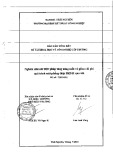
Vietnam Journal of Mathematics 34:3 (2006) 353–356
9LHWQDP-RXUQDO
RI
0$7+(0$7,&6
9$67
The Embedding of Haagerup LpSpaces
Phan Viet Thu
Faculty of Math., Mech. and Inform., Hanoi University of Science
334 Nguyen Trai, Thanh Xuan, Hanoi, Vietnam
Received April 18, 2006
Abstract. The aim of this paper is to give a proof for a theorem due to S. Goldstein
that: If there is a σ- weakly continuous faithful projection of norm one from a von
Neumann algebra Monto its von Neumann subalgebra N, then Lp(N)can be canon-
ically embeded into Lp(M). Here Lp(A)[6] denotes the Haagerup Lpspace over the
von Neumann algebra A.
2000 Mathematics Subject Classification: 46L52, 81R15.
Keywords: von Neumann algebras, Haagerup spaces, conditional expection for von
Neumann algebras.
Let Mbe a von Neumann algebra acting in a Hilbert space Hand ψa normal
faithful semifinite weight on M. Let {σψ
t}t∈Rdenote the modular automorphism
group on Massociated with ψ. The crossed product M=MoσtRis a von
Neumann algebra acting on H=L2(R,H) generated by
(πM(a)ξ)(t)=σψ
−t(a)ξ(t),
(λM(s)ξ)(t)=ξ(t−s)ξ∈H, t ∈R.(1)
Theorem. Let Nbe a von Neumann subalgebra of M. Suppose that ψ|Nis
semifinite and σψ
t|N=σψ|N
tfor each t∈R. Then N, the crossed product of N,
is canonically embeded into Mand for each p∈[1,∞]the space Lp(N)can be
canonically embeded into Lp(M), so that for any k∈Lp(N)
kkkN
p=kkkM
p,
where k.kN
pand k.kM
pdenote the norms of Lp(N)and Lp(M)respectively.

354 Phan Viet Thu
Proof. The condition σψ
t|N=σψ|N
tmeans that ∀b∈N,σψ
t(b)=σψ|N
t(b)∈N,
i.e. σφ
tleaves Ninvariant; Together with the condition that ψ|Nis semifinite,
it implies, by a theorem of Takesaki [5], that there is a σ-weakly continuous
projection Eof norm one of Monto Nsuch that ψ=(ψ|N)◦E. It is not hard
to show that E◦σψ=σψ◦E(see for example, [4, Proposition 3.2]).
Let N=Noσψ|N
t
R, it is a von Neumann algebra acting on L2(R,H)=H,
generated by operators πN(b),b ∈Nand λN(s),s ∈R; defined by
(π(b)ξ(t)=σψ|N
−t(b)ξ(t)),
(λ(s)ξ(t)=ξ(t−s)) ξ∈H, t ∈R.(2)
Sine σψ|N
−t(b)=(σψ
−t|N)(b) for b∈N; (1) and (2) imply
πM|N=πN,(3)
λM=λN,
and M,Nact on the same Hilbert space H.
Let M0be the * algebra generated algebraically by operators πM(a), a∈M
and λM(s),s ∈R. Then Mis the σ-weak closure of M0and any element x0∈M0
can be represented as
x0=
n
X
k=1
λM(sk)πM(ak) for some {sk}n
1⊂R;{ak}n
1⊂M.
We define N0in the same way. Thus ∀y0∈N0,
y0=
m
X
k=1
λN(sk)πN(bk)=
m
X
k=1
λM(sk)(πM|N)(bk)∈M0
for some {sk}m
1⊂R;{bk}m
1⊂N. The σ-weak closure of N0is N. Then we have
N0⊂M0and their σ-weak closures verify N⊂M. It is clear that ∀x∈N⊂
M;||x||(N)=||x||(M).
Consider now the dual action θsof Rin M, characterized by
θs(πM(a)) = πM(a),∀a∈M,
θs(λM(t)) = e−istλM(t),∀t, s ∈R.(4)
By (3), we have
θs(πN(a)) = πN(a),∀a∈N,
θs(λN(t)) = e−istλN(t),∀t, s ∈R.
Thus θs(y0)∈N0for y0∈N0,∀s∈R. So that θs(N0)⊂N0⊂N. Since θsis
σ-weakly continuous on M; for all s∈Rwe have
θs(N)⊂N.
The continuity of θsin measure implies also

The Embedding of Haagerup LpSpaces 355
θs(e
N)⊂e
N
and θM
s|N=θN
s,∀s∈R,
where θM
sand θN
sdenote the dual action θsof Ron Mand on Nrespectively.
By definition of Lp(N) and Lp(M) and the above results, it follows that
Lp(N)={k∈e
N|∀s∈R:θN
sk=e−s
pk}(5)
={k∈e
N⊂e
M|∀s∈R:θM
sk=e−s
pk}⊂Lp(M).
Then we have Lp(N)⊂Lp(M).
It remains now to show that
kkkM
p=kkkN
pfor any k∈Lp(N)⊂Lp(M).
It suffices to demonstrate it for the case p= 1. Note that L1(M)'
M∗;L1(N)'N∗and for any φ∈N∗;φ◦E∈M∗. In [1, 2] the author has
proved that Ecan be extended canonically to ˆ
E:M∧
+→N∧
+;e
E:e
M→e
N
and E1:L1(M)→L1(N), given by h(φ)→hφ◦E. It is extended also to
Ep:Lp(M)→Lp(N); and for any φ∈N∗
φ=(φ◦E)−|N.
Let us calculate the norm of hN
φ=hM
φ◦E. Note that ||hN
φ||(N)
1=||φ||(N)and
||hM
φ◦E||(M)
1=||φ◦E||(M)for any φ∈N∗. We have
kφk(N)= sup
b∈N,kbk≤1
|φ(b)|≥ sup
a∈M,kak≤1
|(φ◦E)(a)|=kφ◦Ek(M)
≥sup
b∈N,kbk≤1
|(φ◦E)(b)|= sup
b∈N,kbk≤1
|φ(b)|=kφk(N).(6)
This implies kφk(N)=kφ◦Ek(M); i.e. khN
φk(N)
1=khM
φ◦Ek(M)
1, which shows that
for any k∈L1(N)⊂L1(M), one has kkk(N)
1=kkk(M)
1. It is now obvious that,
for each p∈[1,∞],
kkk(N)
p=kkk(M)
p,∀k∈Lp(N)⊂Lp(M).
References
1. S. Goldstein, Conditional expectations and Stochastic integrals in non commu-
tative Lp-spaces, Math. Proc. Camb. Phil. Soc. 110 (1991) 365–383.
2. S. Goldstein, Norm convergence of martingales in Lp-spaces over von Neumann
algebras, Revue Roumaine de Math. Pures et Appl. 32 (1987) 531–541.
3. R. V. Kadison and J. R. Ringrose, Fundamentals of the Theory of Operator Alge-
bras, Vol. I, 1983; Vol. II, 1986. Academic Press, New York – London.
4. C. E. Lance, Martingale convergence in von Neumann algebras, Math. Proc.
Camb. Phil. Soc. 84 (1978) 47–56.

356 Phan Viet Thu
5. M. Takesaki, Conditional expectations in von Neumann algebras, J. Funct. Anal.
9(1972) 306–321.
6. M. Terp, Lp-spaces Associated with von Neumann Algebras, Notes Kφbenhavns
Universitet, Matematisk Institut,N0. 3, 1981.





![Báo cáo seminar chuyên ngành Công nghệ hóa học và thực phẩm [Mới nhất]](https://cdn.tailieu.vn/images/document/thumbnail/2025/20250711/hienkelvinzoi@gmail.com/135x160/47051752458701.jpg)










